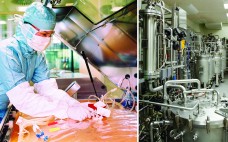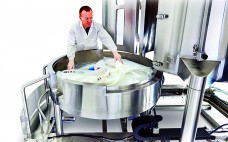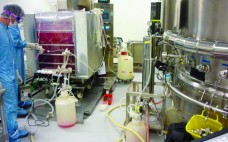Introduction by William P. Flanagan Biopharmaceutical development and manufacturing demand scalable processes that can be quickly developed, easily implemented, and smoothly transferred to production. Disposable, ready-to-use technologies play a crucial role in providing flexibility to support agile biomanufacturing operations. Single-use systems provide process efficiencies by removing steps such as cleaning and cleaning validation, thus allowing for faster change-over between manufacturing runs. The biopharmaceutical industry is increasingly adopting single-use approaches, and the global market for such bioprocessing tools is expected to…
2015
Advances in Bioprocessing: Single-Use and Stainless Steel Technologies
The increasing penetration of disposable devices in the biopharmaceutical manufacturing industry has been well documented, and with good reason. These applications represent a new paradigm in the evolution of biomanufacturing technologies and practices, opening the industry up to new possibilities such as flexible and modular facilities. But stainless steel applications and innovations remain vital to this industry. Some stainless devices may be irreplaceable, including large tanks, autoclavable and heat-sterilized fermentors and bioreactors, and storage and filling devices. Other innovations in…
Disposable Components in Biomanufacturing: A Regulatory Perspective
On a holistic level, the decision regarding whether to use single-use or stainless steel equipment in a biomanufacturing plant is a significant one. It greatly influences the design, construction, layout, and operation of a plant — and consequently, the timing and cost of the overall project. And regulatory review can add an element of risk to using anything new. Disposables have been viewed as a revolutionary concept, and they are. But from a routine regulatory operational perspective, I believe it…
The Single-Use or Stainless Steel Decision Process: A CDMO Perspective
Decisions regarding whether and when to use single-use (SU) (disposable) devices or stainless steel (SS) equipment for biopharmaceutical manufacturing have been discussed for more than a decade. To date, no argument in terms of safety, cost-effectiveness, or operational efficiency is fully convincing to choose one technology platform or the other for all applications. Biopharmaceutical companies often do not have in-use data to make strategic manufacturing decisions. But one group has been significantly growing its expertise in use of single-use technologies:…
Meeting the Demand for a New Generation of Flexible and Agile Manufacturing Facilities: An Engineering Challenge
Classical stainless steel installations in purpose-built facilities dominate the global capacity for commercial biopharmaceutical manufacturing. Early facilities that were designed for single-product processes are now aging, putting them on the investment radar for upgrades to enable manufacturing diversity, and allow more efficient facility use. More than ever before, global engineering leaders are confronted with complex strategic and financial decisions when they seek to invest capital in new flexible pharmaceutical facilities or flex-grading aging facilities for supply of pipeline products. Manufacturing…
End-User Considerations: How Biopharmaceutical Companies and Their Employees Approach Single-Use and Stainless Steel
Along with the other perspectives offered in this special issue, people tasked with actually implementing and working with single-use, stainless-steel, or the more common variations of hybrid systems deserve a say also. When seeking out end-user comments, however, we should consider both the overall company decisions about which systems to use (decisions that may not have accommodated much input from the manufacturing floor) and opinions from individual scientists, technicians, and process engineers themselves who are presented with the facility design and…
Choosing Between Single-Use and Multiuse Technologies: An Interphex 2015 Roundtable Discussion
On Tuesday, 21 April 2015, Eric S. Langer (managing partner at BioPlan Associates) chaired a midday roundtable titled, “Deciding on Single-Use vs. Stainless Steel Bioprocessing Strategy: What Do CMOs Know That Biopharmas Don’t?” Langer brought together several industry experts to discuss choosing between stainless steel and single-use technologies (SUTs) for different applications: William Hartzel (director of strategic execution at Catalent Pharma Solutions) Steven Perry (vice president of technical operations at Cook Pharmica) Joanna Pezzini (bioprocess engineer at MedImmune) Daniel Vellom…
Single-Use and Stainless Steel Technologies: Comparison, Contrast — Where Are They Going?
At a recent conference, there was much talk about a major biopharmaceutical project in Asia for which the owner of a company chose a design with primarily traditional multiuse stainless steel tanks and processing equipment, rather than single-use polymer equipment. There were even some stainless steel equipment vendors toasting at the bar that this may be the beginning of a “renaissance” of stainless steel. Is the single-use systems (SUS) honeymoon over? Are many industry professionals hoping this is the end…
Spotlight
New Sandoz Biosimilar Drug-Product Facility In September 2015, Sandoz (the generics and biosimilars business of Swiss drug maker Novartis) opened its BioInject biomanufacturing facility in Schaftenau, Austria. Over €150 million of investment is creating 100 highly skilled jobs in a state-of-the-art facility for manufacturing prefilled syringes and devices for both biosimilars and novel biologics. Staff can fill 18,000 syringes/hour and package 100 syringes/minute. In welcoming guests at the opening, Carol Lynch (global head of biopharmaceuticals and oncology injectables at Sandoz)…
From the Editor
The BioProcess International Conference took place during the last week in October in Boston, MA — when technical editor Cheryl Scott and I enjoyed meeting with so many of our readers, authors, and advisors as well as the BPI sales staff. We always receive good suggestions from our editorial advisors in our annual meeting with them, and the technical presentations help us craft the final version of our 2016 editorial calendar. As always, congratulations to our Informa colleagues at IBC…








